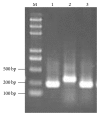Development of a New Marker System for Identification of Spirodela polyrhiza and Landoltia punctata
- PMID: 28168191
- PMCID: PMC5266846
- DOI: 10.1155/2017/5196763
Development of a New Marker System for Identification of Spirodela polyrhiza and Landoltia punctata
Abstract
Lemnaceae (commonly called duckweed) is an aquatic plant ideal for quantitative analysis in plant sciences. Several species of this family represent the smallest and fastest growing flowering plants. Different ecotypes of the same species vary in their biochemical and physiological properties. Thus, selecting of desirable ecotypes of a species is very important. Here, we developed a simple and rapid molecular identification system for Spirodela polyrhiza and Landoltia punctata based on the sequence polymorphism. First, several pairs of primers were designed and three markers were selected as good for identification. After PCR amplification, DNA fragments (the combination of three PCR products) in different duckweeds were detected using capillary electrophoresis. The high-resolution capillary electrophoresis displayed high identity to the sequencing results. The combination of the PCR products containing several DNA fragments highly improved the identification frequency. These results indicate that this method is not only good for interspecies identification but also ideal for intraspecies distinguishing. Meanwhile, 11 haplotypes were found in both the S. polyrhiza and L. punctata ecotypes. The results suggest that this marker system is useful for large-scale identification of duckweed and for the screening of desirable ecotypes to improve the diverse usage in duckweed utilization.
Conflict of interest statement
The authors declare that they have no competing interests.
Figures


Similar articles
-
Mosaic Arrangement of the 5S rDNA in the Aquatic Plant Landoltia punctata (Lemnaceae).Front Plant Sci. 2021 Jun 24;12:678689. doi: 10.3389/fpls.2021.678689. eCollection 2021. Front Plant Sci. 2021. PMID: 34249048 Free PMC article.
-
Biodiversity of Duckweed (Lemnaceae) in Water Reservoirs of Ukraine and China Assessed by Chloroplast DNA Barcoding.Plants (Basel). 2022 May 30;11(11):1468. doi: 10.3390/plants11111468. Plants (Basel). 2022. PMID: 35684242 Free PMC article.
-
The "Duckweed Dip": Aquatic Spirodela polyrhiza Plants Can Efficiently Uptake Dissolved, DNA-Wrapped Carbon Nanotubes from Their Environment for Transient Gene Expression.ACS Synth Biol. 2024 Feb 16;13(2):687-691. doi: 10.1021/acssynbio.3c00620. Epub 2023 Dec 21. ACS Synth Biol. 2024. PMID: 38127817 Free PMC article.
-
Status of duckweed genomics and transcriptomics.Plant Biol (Stuttg). 2015 Jan;17 Suppl 1:10-5. doi: 10.1111/plb.12201. Epub 2014 Jul 4. Plant Biol (Stuttg). 2015. PMID: 24995947 Review.
-
Genomes and Transcriptomes of Duckweeds.Front Chem. 2018 Jun 20;6:230. doi: 10.3389/fchem.2018.00230. eCollection 2018. Front Chem. 2018. PMID: 29974050 Free PMC article. Review.
Cited by
-
Sequence-guided approach to genotyping plant clones and species using polymorphic NB-ARC-related genes.Plant Mol Biol. 2018 Oct;98(3):219-231. doi: 10.1007/s11103-018-0774-1. Epub 2018 Sep 6. Plant Mol Biol. 2018. PMID: 30191440
-
Intraspecific Diversity in Aquatic Ecosystems: Comparison between Spirodela polyrhiza and Lemna minor in Natural Populations of Duckweed.Plants (Basel). 2022 Apr 1;11(7):968. doi: 10.3390/plants11070968. Plants (Basel). 2022. PMID: 35406948 Free PMC article.
References
-
- Landolt E. The Family of Lemnaceae—A Monographic Study, Vol.1. Stiftung Rubel, Zurich: Veroff Geobot Inst ETH; 1986.
-
- Les D. H., Crawford D. J., Landolt E., Gabel J. D., Kimball R. T. Phylogeny and systematics of Lemnaceae, the duckweed family. Systematic Botany. 2002;27(2):221–240.
-
- Lemon G. D., Posluszny U. Comparative shoot development and evolution in the Lemnaceae. International Journal of Plant Sciences. 2000;161(5):733–748. doi: 10.1086/314298. - DOI
-
- Landolt E. The family of Lemnaceae monographic study. Veroeffentlichungen des Geobotanischen Institutes der ETH, Stiftung Rubel, Zurich. 1986;71(1):15–71.
-
- Oron G., Willers H. Effect of wastes quality on treatment efficiency with duckweed. Water Science and Technology. 1989;21(6-7):639–645.
LinkOut - more resources
Full Text Sources
Other Literature Sources

